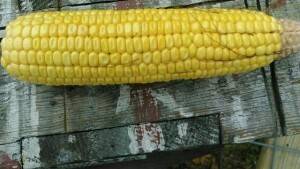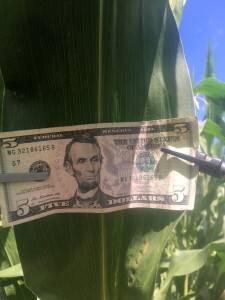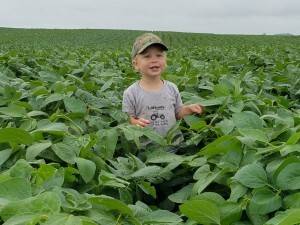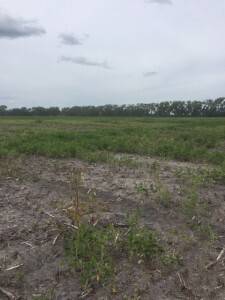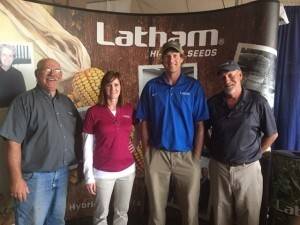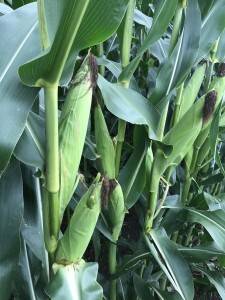From the Field Crop Report: August 16
Northeast Iowa & Southeast Minnesota
Craig Haaland
We got a much needed rain. Last Wednesday 0.4” fell, and then we received another 0.8” on Sunday night into Monday morning. It looks like more is on the way, too.
This corn pictured here is Latham’s popular LH 5215 VT2 PRO RIB. Due to dry growing conditions, it’s showing a little tip back but is still a nice looking field in Grundy County.
The soybean field in Floyd County was planted to Latham’s popular L 2084 R2. We haven’t seen aphid pressure yet here, but keep an eye on your fields. Soybeans are starting to finish out the top of the plant, so hopefully August rains will come and we’ll see some good yields again this fall.
Eastern Iowa
Jerry Broders
Be sure to come to the Latham® Seed-to-Soil Technology Plot at South English on August 29 at 5 pm. Independent agronomist John McGillicuddy will be speaking at the event. Click here for more information about this field day!
North Central Iowa & South Central Minnesota
Cory Greiman
LH 5339 SS looks pretty good, considering the dry conditions. This war measures 18 kernels around by 30 long at 34,000 population.
Central Iowa
Bryan Rohe
Full maturity Latham Liberty Link soybeans doing well in Pella!
West North Central Iowa
Bart Peterson
Check out the power of waterhemp kill with Xtendimax on Xtend soybeans!
Northwest Iowa
Darin Chapman
Latham Hi-Tech Seeds and its dealers understand the importance of service after the sale. That’s why Latham® Seed Representative Andrew Perry used his drone to uncover issues in a grower’s field. We could see where some Nitrogen applicator knives must have been plugged and talked about different tillage practices.
Click here for ideas on how drones may be used during each season of the year.
Southern Wisconsin
Greg Mair
Tonnage and Digestibility are two very important criteria used when selecting Corn Silage Hybrids. Latham Hi-Tech Seeds “Leafy” hybrids offer the perfect package. Leafy hybrids generally have two times more leaves above the ear, increasing both tonnage and digestibility. These soft starch kernels offer the best in starch digestibility for maximum energy intake.
This variety in the photo has tonnage. You can see this leaf has a width of more than 6 inches. This plant is taller than 10 feet and is still stretching. To get the right balance of starch, leafy hybrids perform best for corn silage when planted at populations between 29,000 to 30,000 plants per acre.
If you’re looking for heifer feed, push the population to 32,000 or 34,000 plants per acre. Contact your local Latham Sales Rep or shoot me an e-mail for more information on these leafy genetics.
Eastern North Dakota
Brian McNamee
This Latham® seed rep in training is standing in a field of our LibertyLink soybeans. He likes these experimental 0.7’s the best and thinks they will take the plot. This little guy was such a trooper! He “helped” us sign the plots and even kept that smile when rain started to fall.
Southeast North Dakota
Gary Geske
Check your fields for white grubs and Iron Chlorosis.
Iron Chlorosis is a serious threat to soybeans. There is no such thing as complete resistance to IDC, however, some soybean brands (i.e. varieties) are better than others at handling this condition. Because Latham Hi-Tech Seeds is headquartered right in the heart of North Central Iowa where Iron Chlorosis is a familiar challenge to us, we have always tried to choose soybean genetics that have the best possible scores against this condition. Latham IRONCLAD soybeans are your best defense. Talk to your local Latham® dealer to find out what products are best suited for your fields.
Northeast South Dakota
James Keltgen
We experienced cooler than normal temps again this week. While more rain fell, it came with hail. Corn is in the milk to dough stage. No insect pressure but starting to see some aphids.
Southeast South Dakota
Ramie Coughlin
The skies are cloudy and dropping some moisture as we kickoff Dakota Fest in Mitchell, SD.
Northern Minnesota
Ken Highness
This field in Clay County Minnesota is severely damaged by white grubs, which are sometimes called May/June beetles. As the picture shows, the damage is wide spread in this quarter section. There is no rescue treatment available for white grubs in soybeans.
Southern Minnesota
Brandon Wendlandt
We have been blessed with ample rainfall this season so far in southern Minnesota. This is a picture of 5025 VT2 DroughtGuard, planted on sandy soils at a lower population.
Look at both of those ears on one stalk! I’m looking forward to weighing this corn.

